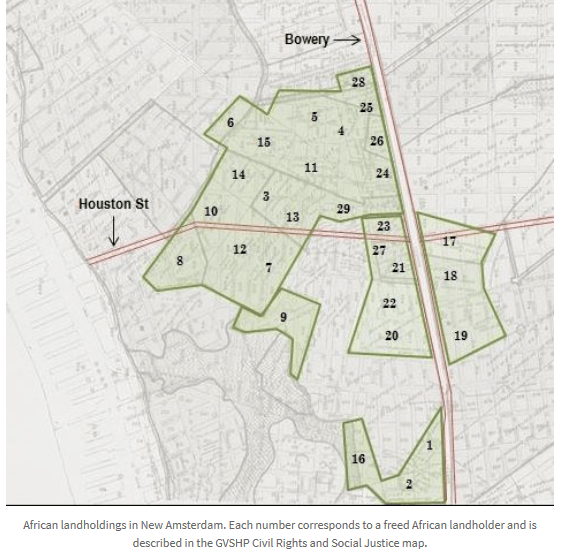SoHo has is most commonly known for its rich artistic legacy and distinguished architecture, but in the many layers of its past lies the lesser-known stories of the role played by the neighborhood in African American history. According to Historian Christopher Moore, what is now SoHo was home to the very first enclave of emancipated African American people in all of the United States. Since that time, African American New Yorkers have been repeatedly displaced and excluded for centuries, making SoHo a space where racial lines have constantly been contested and redrawn. This Black History month, we look back on the significance of African American history in SoHo.
During the 1620s, the Dutch West India Company captured 11 people of African descent, enslaved them, and sent them to Manhattan by force to create the colony of New Amsterdam. By 1644, the enslaved group fought against the company for their emancipation and negotiated a status attaining “half-freedom” wherein they were able to achieve wages, have the right to marry, own property, and testify in court. This type of partial emancipation also entailed the allocation of several tracts of land for living and farming purposes — which included large swathes of what is known today as SoHo. The neighborhood came to be known as the “Land of the Blacks”, with the emancipated populations occupying 130 acres of land in present day lower Manhattan. While the Dutch system of partial emancipation was still in deep violation of human rights, being able to own and farm land enabled the earliest Black New Yorkers forms of autonomy that was unfortunately taken away from future generations.
In 1664, these Black landowners were forced to give up their land once England took over New Amsterdam. The majority of it was transferred to wealthier, white landowners who continued to own sizable estates in the area for the following century. By the middle of the 19th century, these estates were gradually parceled out and sold — increasingly becoming home to an growing number of working-class Italian, Jewish, and Irish immigrants — but the neighborhood continued to have the largest Black population in the city.
The Eight Ward, within Houston Street, Broadway, West Broadway, and Canal Street as its perimeter, was home to 7% of the city’s population and 18% of New York’s Black population in 1850. Sections of what are now western SoHo/South Village north of Spring Street to Washington Square nearby became known as “Little Africa“.

As New York City industrialized, the majority of Black families once again had their properties taken away in downtown Manhattan. Later in the 1800s, when the City decided to expand West Broadway to Waverly Place, 700 residents, the majority of whom were Black, were displaced as a result of the destruction of 127 properties. Soon after, it was replaced by the Romanesque- and Renaissance-revival lofts which are protected by the City’s historic preservation laws today.
In conversations surrounding the preservation of the neighborhood’s character and legacy, it is important to consider all aspects of history in SoHo, where racial lines were continuously redrawn and contested, and think about whose culture and community is preserved and whose was destroyed.